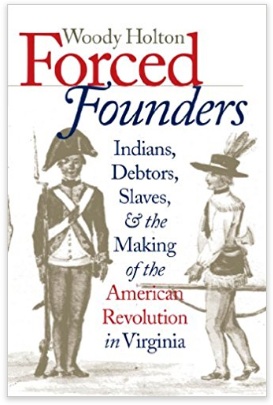In our next social history look at the American Revolution in Virginia, we feature four books on African American history. “Slavery and Freedom” investigates the results of the Revolution on slave and free black families in the Chesapeake and elsewhere and the development of autonomous black communities. “Water from the Rock” describes the social and military roles of slaves in the Revolution, eventual resettlement in the Atlantic Basin, and adoption of Revolutionary ideology in black churches.
“The Internal Enemy” treats slavery in Virginia during the expanded revolutionary epoch from 1774 through the Revolution, the War of 1812 to Nat Turner’s Rebellion. “Forced Founders” charts the pressures encumbering the Virginia colonial gentry during the Revolutionary era by slaves, Native Americans and white smallholders.
See more reviews on Revolutionary Virginia history at our webpage Revolution-Constitution-New Nation. General surveys of Virginia History can be found at Virginia History Surveys. Virginia history divided by time periods can be found at the webpage Books and Reviews.
Slavery and Freedom

Slavery and Freedom in the Age of the American Revolution was written by Ira Berlin and Ronald Hoffman in 1986. It is a collection of essays accenting the ambiguous effects on African American slave and free families resulting from the American Revolution. The impacts varied among three distinctive slave systems in colonial America: northern seaport cities, the Chesapeake, and the South Carolina-Georgia low country and the frontier Southwest.
Family behaviors between whites and blacks were remarkably different, yet alike in their resident households and tight kinship ties. Forced emigration to the old Southwest Gulf states was initially disruptive of slave family life, but they quickly reformed among newly established black communities.
The Revolution was a watershed of race relations. Slave-holders developed an explicit legal and social argument of racial inferiority to justify their failure to emancipate “all men created equal”, but at the same time the Great Awakening among black preachers effected religious autonomy among black evangelicals. Learn more to buy “Slavery and Freedom” here for your bookshelf.
Water from the Rock

Water from the Rock: Black Resistance in a Revolutionary Age was written by Sylvia Frey in 1992. The book is divided into two parts. The first explores the roles of slaves in the Revolutionary War, both military and social. The war was triangular, among Patriots, British and an activist slave population. About 30,000 ran to the British, with a total of 80-100,000 leaving their owners. These formed maroon colonies, disappeared in the free black communities of Baltimore or Charleston, or joined with the British, who could treat the boldest of slaves with harshness in menial labor. The British impulse to disrupt the gentry slave holding South had the effect of unifying whites as patriotic Rebels.
Part two of the book looks at the aftermath of the Revolution for American enslaved populations and the largest group of loyalist exiles, the British African Americans. The former republican rebel idealists turned to a more racist justification for enslavement, while Baptists and Presbyterians developed a doctrine of mutual obligations in a kind of paternalism. But black churches seized upon that paternalism to develop a racially distinct value system that resisted white cultural domination. Learn more to buy “Water from the Rock” here for your bookshelf.
The Internal Enemy

The Internal Enemy: Slavery and War in Virginia, 1772-1832 was written by Alan Taylor in 2014. In twelve chapters, this book spans the context of Virginia history from 1772, encompassing Governor Dunmore’s emancipation of 1775, additional British emancipations over the course of the War of 1812, through Nat Turner’s Rebellion of 1832.
Runaways, after securing their freedom at the hands of the British, often returned to their plantations to release family and friends. Free blacks settled in Nova Scotia, New Brunswick, Bermuda and Trinidad. Learn more to buy “The Internal Enemy” here for your bookshelf.
Forced Founders

Forced Founders: Indians, Debtors, Slaves and the Making of the American Revolution in Virginia was written by Woody Holton in 1999. The thesis of the book is that the American Revolution as led by the gentry in Virginia was less “a display of confidence than an act of desperation”.
The gentry were confronted by challenges from British imperial rule and merchant allies with taxes and indebtedness, Native American from the Cherokees to the south to the Ohio Valley tribes resisting westward expansion, and many white smallholders refusing to pay rents and requiring more republican military units and representation in the House of Burgesses, and finally slaves were not only sources of labor, but authors of resistance in their own right.
Each of these groups exercised their own agency to undercut the gentry’s command of home rule by bringing into question who would rule at home. Learn more to buy “Forced Founders” here for your bookshelf.
See more reviews on Revolutionary Virginia history at our webpage Revolution-Constitution-New Nation. General surveys of Virginia History can be found at Virginia History Surveys. Virginia history divided by time periods can be found at the webpage Books and Reviews.

